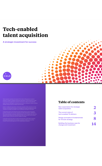Download available
Tech-enabled talent acquisition: A strategic investment for success
Talent acquisition leaders are rethinking their strategies due to the wildly unpredictable job market, which is currently seeing candidate demand significantly outpace supply. Today's job seeker has many options, and HR technology can help TA functions adapt to and address these fluctuating market conditions. While the HR technology space is seeing immense investments and growth, not all tech is created equally. To future-proof strategies, leaders must focus on both short- and long-term business goals when considering a new tech purchase.
The latest insights from HRO Today demonstrate just how much money is entering the HR and TA technology sector – from startups securing seed funding to large company acquisitions. With the entire hiring process disrupted by shifts to virtual operations, technology companies are offering new solutions to recruitment challenges such as job advertising, interview scheduling, and candidate communication.
Beyond virtual hiring practices, candidate expectations are changing too. The employer value proposition, job structure, and employee perks and benefits that were once appealing have changed, rewarding organizations that adapt quickly to today’s new candidate and employee needs. The right HR technology strategy can help a company highlight its unique offerings to quickly attract the candidates they need with an optimized hiring process and positive candidate experience.
It can be easy to go for the flashiest technology offering or the product that solves a specific pain point. However, TA leaders must assess how current business challenges correlate with their organizational vision for the future when choosing to invest in tech. That way, no matter the internal or external changes that occur, their approach continually evolves to meet business goals. Staying informed on advancements in the space is imperative, but do not let that distract from what is truly important – delivering all candidates a compelling hiring experience to help an organization earn the talent necessary to succeed.
Due to the ever-changing market and continual innovations in technology, the future of talent acquisition requires a seamless, integrated technology platform. A platform model supports an agile ecosystem of point solutions catering to different use cases or new innovations while maintaining a centralized place from which to work, drive a consistent user experience and manage data. Equipped with an open API integration layer, a technology platform model delivers unified data for meaningful reporting and predictive analytics throughout the recruitment process. This open framework also provides flexibility to add and edit point solutions without undergoing a lengthy change exercise.
So, how can talent leaders find the best tech-enabled talent acquisition approach to achieve both short- and long-term business goals? Consider following this four-step process:
Take the list of pain points and aspirations that may have seemed unachievable in the past and think about how technology can enable those ideas. Gather honest feedback. Go to your team and key stakeholders to ask the tough questions including:
Inventory every HR technology solution you currently have across the entire lifecycle of the hiring process. Assess current adoption or utilization, overall user satisfaction, and any gaps in expected performance or value delivered. Use this to identify redundancies in solution offerings or gaps in terms of unaddressed hiring process steps.
Build your requirements list for a successful tech strategy going forward. To scope the vision, decide which statement best reflects your current state and the opportunity you have for change.
Finally, look beyond your current state and the gaps driving the size of your opportunity. Consider these future-focused technology requirements to push you to think past the next six to 12 months and instead, focus on what is possible:
The growing HR and TA technology market offers more opportunities to solve talent acquisition challenges. But we must first evaluate what is best for our organizations – now and in the future.
To learn more about the concepts you should consider when investing in new tech or contemplating changing your technology model, our guide view our guide below.

Download available
Tech-enabled talent acquisition: A strategic investment for success
About the expert
Former Senior Vice President – Technology Consulting, Cielo
LinkedIn connect